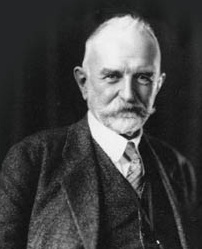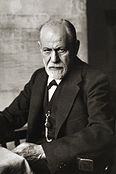
Developmental psychology is the scientific study of how and why humans grow, change, and adapt across the course of their lives. Originally concerned with infants and children, the field has expanded to include adolescence, adult development, aging, and the entire lifespan. Developmental psychologists aim to explain how thinking, feeling, and behaviors change throughout life. This field examines change across three major dimensions, which are physical development, cognitive development, and social emotional development. Within these three dimensions are a broad range of topics including motor skills, executive functions, moral understanding, language acquisition, social change, personality, emotional development, self-concept, and identity formation.

In sociology, socialization is the process of internalizing the norms and ideologies of society. Socialization encompasses both learning and teaching and is thus "the means by which social and cultural continuity are attained".
A role is a set of connected behaviors, rights, obligations, beliefs, and norms as conceptualized by people in a social situation. It is an expected or free or continuously changing behavior and may have a given individual social status or social position. It is vital to both functionalist and interactionist understandings of society. Social role theory posits the following about social behavior:
- The division of labour in society takes the form of the interaction among heterogeneous specialized positions, we call roles.
- Social roles included appropriate and permitted forms of behavior and actions that recur in a group, guided by social norms, which are commonly known and hence determine the expectations for appropriate behavior in these roles, which further explains the position of a person in the society.
- Roles are occupied by individuals, who are called actors.
- When individuals approve of a social role, they will incur costs to conform to role norms, and will also incur costs to punish those who violate role norms.
- Changed conditions can render a social role outdated or illegitimate, in which case social pressures are likely to lead to role change.
- The anticipation of rewards and punishments, as well as the satisfaction of behaving pro-socially, account for why agents conform to role requirements.

In sociology, a peer group is both a social group and a primary group of people who have similar interests (homophily), age, background, or social status. The members of this group are likely to influence the person's beliefs and behaviour.

George Herbert Mead was an American philosopher, sociologist, and psychologist, primarily affiliated with the University of Chicago. He was one of the key figures in the development of pragmatism. He is regarded as one of the founders of symbolic interactionism, and was an important influence on what has come to be referred to as the Chicago School of Sociology.

Charles Horton Cooley was an American sociologist. He was the son of Michigan Supreme Court Judge Thomas M. Cooley. He studied and went on to teach economics and sociology at the University of Michigan.
Role theory is a concept in sociology and in social psychology that considers most of everyday activity to be the acting-out of socially defined categories. Each role is a set of rights, duties, expectations, norms, and behaviors that a person has to face and fulfill. The model is based on the observation that people behave in a predictable way, and that an individual's behavior is context specific, based on social position and other factors. Research conducted on role theory mainly centers around the concepts of consensus, role conflict, role taking, and conformity. The theatre is a metaphor often used to describe role theory.

Piaget's theory of cognitive development, or his genetic epistemology, is a comprehensive theory about the nature and development of human intelligence. It was originated by the Swiss developmental psychologist Jean Piaget (1896–1980). The theory deals with the nature of knowledge itself and how humans gradually come to acquire, construct, and use it. Piaget's theory is mainly known as a developmental stage theory.
In psychoanalysis, psychosexual development is a central element of the sexual drive theory. According to Freud, personality develops through a series of childhood stages in which pleasure seeking energies from the child become focused on certain erogenous areas. An erogenous zone is characterized as an area of the body that is particularly sensitive to stimulation. The five psychosexual stages are the oral, the anal, the phallic, the latent, and the genital. The erogenous zone associated with each stage serves as a source of pleasure. Being unsatisfied at any particular stage can result in fixation. On the other hand, being satisfied can result in a healthy personality. Sigmund Freud proposed that if the child experienced frustration at any of the psychosexual developmental stages, they would experience anxiety that would persist into adulthood as a neurosis, a functional mental disorder.
Ego psychology is a school of psychoanalysis rooted in Sigmund Freud's structural id-ego-superego model of the mind.

In criminology, social control theory proposes that exploiting the process of socialization and social learning builds self-control and reduces the inclination to indulge in behavior recognized as antisocial. It derived from functionalist theories of crime and was developed by Ivan Nye (1958), who proposed that there were three types of control:
Personality development encompasses the dynamic construction and deconstruction of integrative characteristics that distinguish an individual in terms of interpersonal behavioral traits. Personality development is ever-changing and subject to contextual factors and life-altering experiences. Personality development is also dimensional in description and subjective in nature. That is, personality development can be seen as a continuum varying in degrees of intensity and change. It is subjective in nature because its conceptualization is rooted in social norms of expected behavior, self-expression, and personal growth. The dominant viewpoint in personality psychology indicates that personality emerges early and continues to develop across one's lifespan. Adult personality traits are believed to have a basis in infant temperament, meaning that individual differences in disposition and behavior appear early in life, potentially before language of conscious self-representation develop. The Five Factor Model of personality maps onto the dimensions of childhood temperament. This suggests that individual differences in levels of the corresponding personality traits are present from young ages.
Social learning is learning that takes place at a wider scale than individual or group learning, up to a societal scale, through social interaction between peers.
Social conditioning is the sociological process of training individuals in a society to respond in a manner generally approved by the society in general and peer groups within society. The concept is stronger than that of socialization, which is the process of inheriting norms, customs and ideologies. Manifestations of social conditioning are vast, but they are generally categorized as social patterns and social structures including nationalism, education, employment, entertainment, popular culture, religion, spirituality and family life. The social structure in which an individual finds him or herself influences and can determine their social actions and responses.
Identification is a psychological process whereby the individual assimilates an aspect, property, or attribute of the other and is transformed wholly or partially by the model that other provides. It is by means of a series of identifications that the personality is constituted and specified. The roots of the concept can be found in Freud's writings. The three most prominent concepts of identification as described by Freud are: primary identification, narcissistic (secondary) identification and partial (secondary) identification.

The Sociology of emotions applies a sociological lens to the topic of emotions. The discipline of Sociology, which falls within the social sciences, is focused on understanding both the mind and society, studying the dynamics of the self, interaction, social structure, and culture. While the topic of emotions can be found in early classic sociological theories, sociologists began a more systematic study of emotions in the 1970s when scholars in the discipline were particularly interested in how emotions influenced the self, how they shaped the flow of interactions, how people developed emotional attachments to social structures and cultural symbols, and how social structures and cultural symbols constrained the experience and expression of emotions. Sociologists have focused on how emotions are present in the creation of social structures and systems of cultural symbols, and how they can also play a role in deconstructing social structures and challenging cultural traditions. In this case, in order to understand the mind, affect and rational thought must be considered since humans find motivation among non-rational factors such as levels of emotional commitment to norms, values, and beliefs. Within sociology, emotions can be seen as social constructs that are fabricated by interaction and collaboration between human beings. Emotions are a part of the human experience, and they gain their meaning from a given society's forms of knowledge.
Display rules are a social group or culture's informal norms that distinguish how one should express oneself. They function as a way to maintain the social order of a given culture, creating an expected standard of behaviour to guide people in their interactions. Display rules can help to decrease situational ambiguity, help individuals to be accepted by their social groups, and can help groups to increase their group efficacy. They can be described as culturally prescribed rules that people learn early on in their lives by interactions and socializations with other people. Members of a social group learn these cultural standards at a young age which determine when one would express certain emotions, where and to what extent.
In sociology and other social sciences, internalization means an individual's acceptance of a set of norms and values through socialisation.
Psychodynamic models of emotional and behavioral disorders originated in a Freudian psychoanalytic theory which posits that emotional damage occurs when the child's need for safety, affection, acceptance, and self-esteem has been effectively thwarted by the parent.
Moral development focuses on the emergence, change, and understanding of morality from infancy through adulthood. The theory states that morality develops across the lifespan in a variety of ways. Morality is influenced by an individual's experiences, behavior, and when they are faced with moral issues through different periods of physical and cognitive development. Morality concerns an individual's reforming sense of what is right and wrong; it is for this reason that young children have different moral judgment and character than that of a grown adult. Morality in itself is often a synonym for "rightness" or "goodness." It also refers to a specific code of conduct that is derived from one's culture, religion, or personal philosophy that guides one's actions, behaviors, and thoughts.











